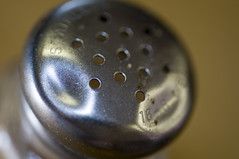What is the best way to take salt?

We all know that too much salt may increase the risk of high blood pressure, hypertension, stroke, heart failure and the list goes on. We maybe eating a healthy balanced diet right now, but chances are these foods may contain too much salt. So, what is the best way to take salt?
On average, Australian adults consume between eight to 12 grams of salt a day, almost double the six grams per day that the National Health and Medical Research Council recommends. And all this salt is killing us.
Risks for healthy adults
But if you think you don't need to worry until your blood pressure starts to go up, think again. You can be at increased risk of some of these health problems even if your blood pressure is perfectly normal, says Professor Peter Clifton, research nutritionist and co-author of the CSIRO Wellbeing Diet.
In fact it can raise the risk of stroke by as much as 23 per cent and heart attack by as much as 14 per cent, a study published in the British Medical Journal last year suggests.
Salt can also play a role in range of other health conditions, such as osteoporosis, stomach cancer, diabetes and asthma.
Processed foods
The ingredient in salt that causes all these problems is sodium. And in Australia, about 75 per cent of our sodium comes from processed foods. A further 15 per cent is added either during cooking or at the table, and the other 10 per cent is naturally-occurring.
While foods such as anchovies, olives and fish sauce are known to be heavy hitters when it comes to salt content, Neal says they are not where most people get their salt.
Obviously you can have some really high salt foods, but if you don't eat much of them then it doesn't really matter. It's the things like breakfast cereals, bread, processed meats, cheeses and some other dairy products where Australians get the majority of their salt, he says.
But there is some good news, with bread makers agreeing to a voluntary limit of 400 milligrams of sodium per 100 gram serve of bread, changes that will be introduced gradually over the next four years. This is a result of the growing pressure on food manufacturers to set upper limits on the amount of sodium they add to food.
The key is ... to take small amounts of salt out of as many foods as possible, Neal says.
Reading labels
But there's plenty you can do to reduce your salt intake yourself. One way is to start reading labels. The milligrams of sodium in 100 grams of a food is shown on its nutrition panel. This helps you gauge how salty the product is compared to others in the same category.
Foods that contain less than 120 mg of sodium per 100 grams are generally considered low-salt foods, while those that have sodium levels above 500 mg per 100 grams are high salt foods, Neal says.
A survey of the sodium levels in Australian processed food, co-authored by Neal, found there is often considerable variation in the amount of salt contained in different brands of foods that belong to the same food categories.
Look at canned tomatoes, for example. If you buy the right canned tomatoes, they have no sodium in them at all. But if you buy the wrong ones they have 100 times more sodium in them, Neal says.
Peter Clifton concedes low-salt varieties can be hard to find, but says if you shop around you can find them or when they appear on the shelves then you should just buy lots of them..
So you can reduce your salt consumption by buying low-salt or salt-free foods. But eating less processed food will also help.
Other tips include:
- Cutting down on salty ingredients like soy sauce and pre-made pastes when you make stir fries and curries. (Use garlic, ginger, chilli, fresh herbs and lemon or lime juice to enhance flavours instead.)
- Making a pasta sauce with fresh tomato, garlic, onion and fresh herbs, rather than using a bottled pasta sauce.
- Roasting meats at home - such as chicken, beef or pork - for use on sandwiches instead of processed meats.





















